Article
Ojai Valley Part I: Yesterday's People
Author(s):
Many people who have settled in Southern California's Ojai Valley have felt the same mystique the Chumash Indians valued in the land. Early settlers embraced the clean air and bathed in the hot sulphur springs.
The land of the Crescent Moon in Southern California was free. Free of discord. Free of intruders. Only the Chumash lived in this virgin land, some say they could be found as far back as 6000 B.C. in the so-called Millingstone Horizon. The Chumash were the bead makers, the rock artists, the basket makers (with their baskets now proudly on display in our Smithsonian and in the Museum of Mankind in Paris, France) — but, more important, they were the first people.
They were a maritime coastal tribe living in a land of plenty. They sailed their boats as far as the Channel Islands 30 miles off shore. Most of their food came from the sea. They fished and dug for clams, hunted quail and duck, ate nuts and seeds, and made soup from oak acorn flour.
They were content. Their land had all they needed. It had fresh water lakes and it had mountains, mountains that became part of their religion.
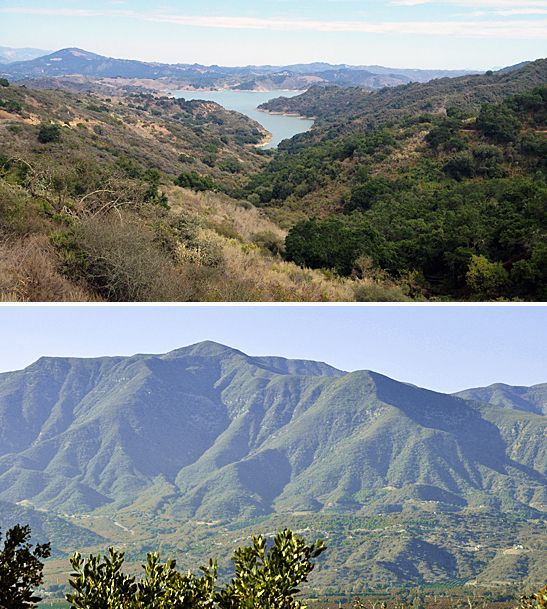
Mountains have always been a spiritual place for native cultures and for those contemporaries who follow them. The Chumash called their Bluffs topatopa and only the pure were allowed access to them.
The Chumash felt the valley had healing properties. This spirituality, this mystique has been felt by many people who have come and settled in the Ojai Valley. The early settlers embraced the clean air and bathed in the hot sulphur springs. Some of today’s residents are here for the same reason: a local seeing us standing in the park and studying a map comes over to tell us that James Hilton’s 1933 novel Lost Horizon was filmed in Ojai because the valley was already seen as a Shangri-La.
“There is a vortex here,” he says, “an electromagnetic force that was even noticed by the astronauts in outer space. It looked like water going down a drain. It’s caused by the collision of the North American Plate moving north on the Pacific Plate.
“Enjoy,” he says with a smile and moves away.
We look around and try to remember our Plate Tectonics. We’re not really worried. We’ve been living near the San Andreas Fault for a long time.
“The less we know about our history, the easier it will be to invent it,” a Texas museum curator once told us. The curator was talking about other people — he surely wouldn’t be referring to Ojai town historian Cricket Twichell. She conducts one-hour historical tours of the city every Saturday except during the heat of summer. A transplant from the Berkshires on the East Coast, she came to Ojai in 1969 with her husband, Terry, a math teacher, “to stay for just a few years.” They have been here ever since.
Cricket is disarmingly open as she walks around town. (“I don’t really like Southern California,” she tells us, “but I love Ojai.”) She loves Ojai’s story. The story of its first church, for example, the old Presbyterian Church: Ojai Historic Landmark number one.
She is standing in front of it now comparing its present day appearance with an original photograph from 1882. It looks the same, but it was moved from its original location when it was replaced by a new church. The story is quite complicated for the newcomer but the town’s annals help to explain. So does Cricket.
In an earlier time, 1871, reporter Charles Nordhoff visited Southern California for his newspaper and subsequent books. He was captivated by what it offered “pleasant homes…rich soil…cheap land…and a climate the best, probably, in the United States.”
Nordhoff was born in Germany in 1830 and came to Missouri with his father in 1834. A synopsis of his busy life (he died in 1901) doesn’t show the influence on America of the 17 books he created from his travels especially the important one to the town of Ojai: California: A Book For Travellers And Settlers.
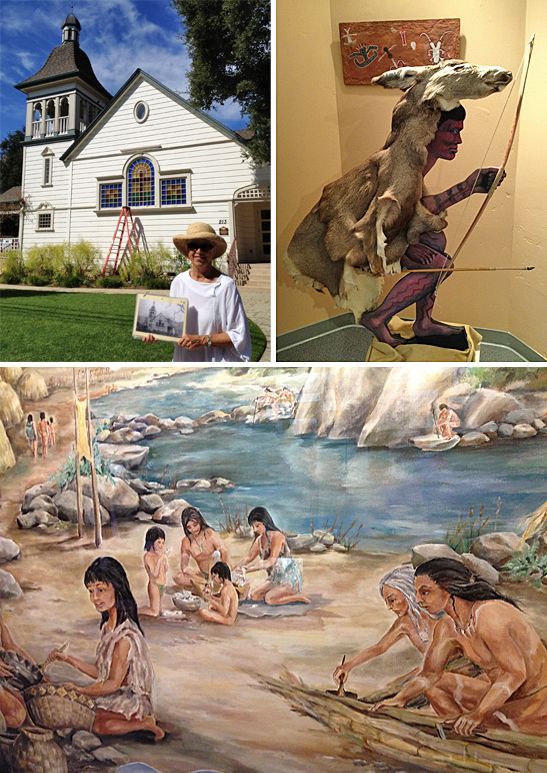
The walking map provided by Ojai makes explorations of its streets easy, but without Cricket’s narration visitors might not know what they were looking at, here the Old Presbyterian Church. In the Ojai Valley Museum, three blocks to the west on Ojai Avenue, Cricket takes visitors back in time to the original inhabitants: the Chumash Indians.
Nordhoff’s writings created almost a passion of people pouring in from the East Coast excited, as so many were then, by what California had to offer. Those who came to this favored spot in the valley — between the two mountain ranges that ran east to west in the 7,000 square miles of Chumash lands — built a town and called it Nordhoff. (In World War I the name was thought too German and was changed back to the original Chumash name, Ojai, which means Crescent Moon.)
The Chumash worshipped the Sun as their god, they marked the seasons that their lives depended on, and as they became more advanced their villages became more permanent. They lived in large houses that accommodated as many as 50 persons, in rooms separated by hanging mats made of reeds. The homes were made of willow branches, reinforced by whalebone and roofed with tulle mats. They had stone cookware, the ability to store food and the time to create art and dance.
“Their society became tiered ranging from manual laborers to skilled craftsmen,” says a placard in the museum. “Women could serve equally with men as chiefs and priests.”

The Chumash Indians built sophisticated boats. They used fallen redwood from the coast farther north to create ocean going plank canoes called tomols that they sealed with molten tar. They hunted small animals and were competent fishers. Their lands stretched to the Channel Islands.
Each village had its shaman who charted the heavens like the medieval astrologers in Europe. He guided the villagers according to his predictions.
“The history was passed down from generation to generation through stories and legends. Most of those stories were lost when the Chumash Indian population was all but decimated in the 1700s and the 1800s by the Spanish Mission system.”
The exploitation of those Native American villagers by the Church and the eventual genocide that wiped them out is not readily forgiven by today’s reality that Indian gambling has made some tribes wealthy. A guide in Santa Ynez, 60 miles to the west where the only sub-tribe of the Chumash has sovereign status, tells us “it has built a very successful casino and that each of the slightly more than 100 Chumash who share the profits get an average of half a million dollars every year.”
The following morning Greg Bressani, a former forestry ranger from Sedona and now a guide for Cloud Climbers Jeep and Wine Tours comes to our inn for our “All Around Ojai” half-day private tour ($109 per adult in a seven-seat open air, canopy-covered custom Jeep) and by chance we are the only two passengers).
We knew we would do some sampling of local olive oils and wine tasting but particularly wanted to hear more about the Chumash, who seem similar to the Kumeyaay who came to live around the San Diego River 12,000 years ago.
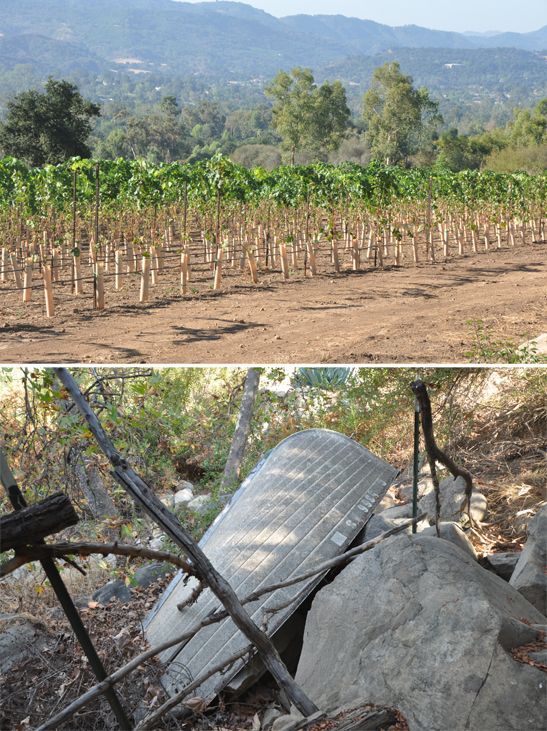
Greg initially drives us along town streets and country lanes past interesting homes and developing vineyards until we reach a trail that follows a dried up river bed. “If you were standing here 65 million years ago, you’d be standing in the ocean!” he says. The trail is well shaded by the trees around us, fortunately, because mountains that run east and west do not break the pervasion of the sun. It can be hot in Ojai. We pass an old beached row boat on the private land off the trail. It may be tongue-in-cheek art but we suggest to Greg, “Maybe there was an ocean here millions of years ago “
The trail, sometimes bordered by river boulders leads us into the land that was home to the Chumash. It met all their nutritional and medical needs. Greg shows us how a bamboo-like plant could be straightened by heat and used as the shaft of an arrow. The Chumash would trade for the arrowheads with other tribes if they had to.
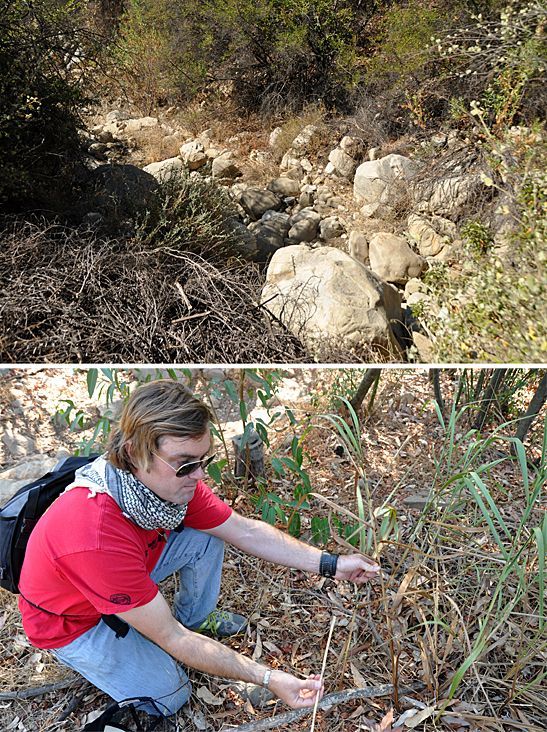
In the dense foliage the prey hunted were deer and small animals. A native hunter might have ten laboriously created arrows. The sharpened end would be inserted into the hollow stem so if the arrow hit a rock for example, only the end would be destroyed; the main body of the arrow could be used again.
Greg shows us a dried up Californian Coastal Sage. We rub the stem vigorously and smell the thyme-like perfume.
“The Chumash used it for their cleansing rituals before festivals,” Greg says.
We find a California White Sage, which creates great incense for respiratory problems, and a Black Sage with its sweet honeysuckle smell used for its chia seeds. A useful method of Chumash fishing included dropping the chia seeds into small ponds to be snapped up by fish. The seeds are hydroscopic and, swelling in water, collect in the fish’s gills. The fish die and, floating to the surface, can be collected as food. If you had fishy-smelling hands after that you could use the seeds of the Mountain Laurel, which become like soap when water was added.
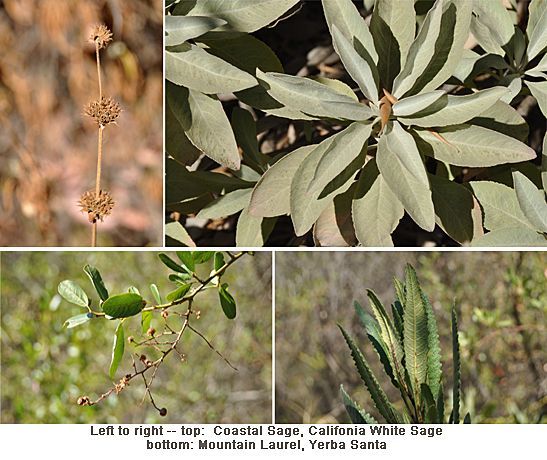
Nothing was wasted in a Chumash forest. They found a use for every plant.
Greg points at a Yerba Santa with its leathery leaves; it can coat the mucous membranes and be useful as an expectorant, he tells us. Nothing was wasted: the leaves could be smoked and the flowers boiled to make a soothing tea.
Later we read a placard that states: “Yerba Santa frees the lungs and heart to acknowledge and release stored emotional experience. Yerba Santa was regarded as a holy herb by the native peoples, because the process of awakening, and claiming deep soul experience leads to the indwelling Temple of the Spiritual Self.”
Today’s physicians must surely miss yesterday’s patients who were practically cured even before they were handed their magical remedies.
The Andersons, who live in San Diego, are the resident travel & cruise columnists for Physician's Money Digest/Lifestyle. Nancy is a former nursing educator, Eric a retired MD. The one-time president of the NH Academy of Family Practice, Eric is a member of the Motor Press Guild and the only physician in the Society of American Travel Writers. He has written five books, the last called The Man Who Cried Orange: Stories from a Doctor's Life.




